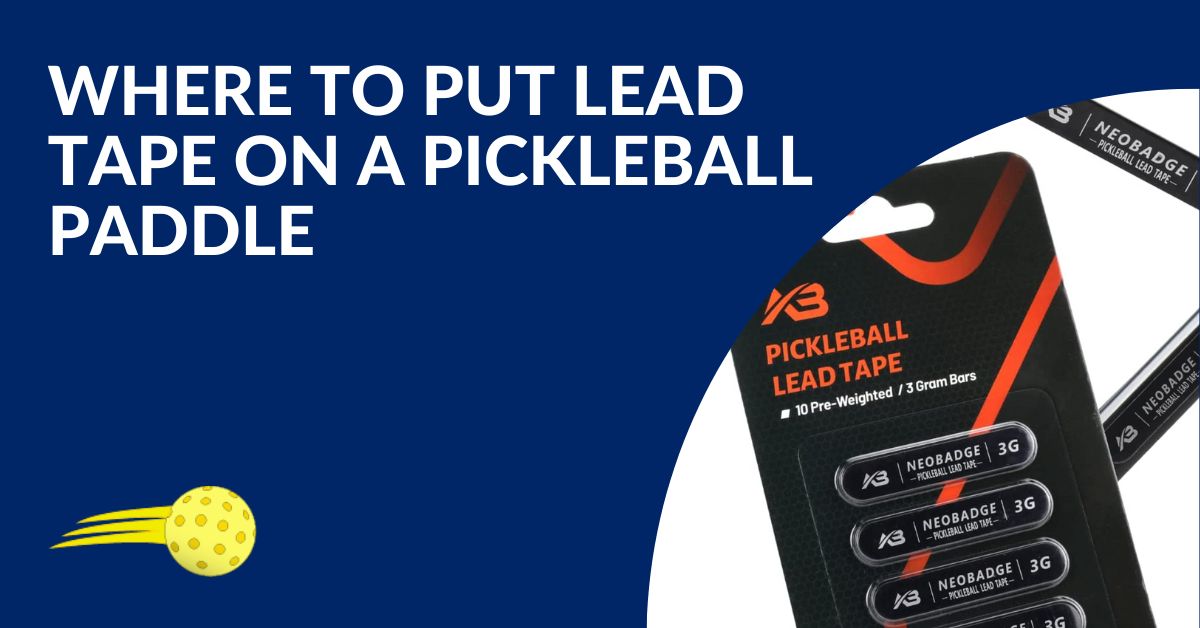Welcome to the ultimate guide on using pickleball lead tape to enhance your pickleball paddle’s performance. If you’re new to the world of lead tape, you might be wondering what the fuss is all about. In this comprehensive blog post, we’ll explore everything you need to know about lead tape, from choosing the right tape to determining where to place it on your paddle.
Lead tape can be a game-changer in pickleball, offering benefits like increased power, better control, reduced paddle twisting, and an expanded sweet spot. It has the potential to transform a paddle you might not love into one that’s perfect for your playing style. Let’s dive in and uncover the secrets of using lead tape effectively.
Table of Contents
- Search Lead Tape on Amazon
- Choosing the Right Lead Tape
- How Much Lead Tape to Use and Where to Place It
- Understanding Swing Weight and Its Impact
- Placing Lead Tape: Head, Sides, Throat, or Handle?
- How to Weigh and Apply Lead Tape
Choosing the Right Lead Tape
Before you start adding lead tape to your paddle, it’s crucial to select the right tape for your needs. There are a few key considerations to keep in mind:
Toxicity Concerns
Lead tape contains lead, which can be toxic if ingested or handled improperly. If you’re worried about toxicity or prefer not to cover your lead tape with electrical tape, you can opt for tungsten tape. Tungsten tape is safe to touch and use. While there aren’t as many tungsten tape options available, Selkirk offers a safe tungsten tape option.
Tape Width
The two primary tape widths available are half inch and quarter inch. The choice between them depends on your paddle type. Thinner paddles with no edge guard are better suited for quarter inch tape. Using half inch tape on such paddles may lead to the tape bleeding onto the paddle’s face and a less clean look.
Weight per Inch
Lead tape comes in different weights per inch, typically 0.25 grams per inch and 0.5 grams per inch. It’s advisable to choose the heavier option because adding sufficient weight to your paddle often requires longer strips and layering. The lighter 0.25 grams per inch tape may not provide the desired impact.
Paddle Type
Consider your paddle type when selecting lead tape. For paddles with an edge guard, thicker and wider lead tape options are suitable. For thinner, edgeless paddles, quarter inch tape or Selkirk’s tungsten tape may be preferred.
Pre-Cut Strips
Pre-cut strips are a convenient option for many players. They eliminate the need for measuring and cutting, and you can easily determine the exact weight of each strip. This simplifies the lead tape application process and is especially useful for experimenting with different setups.
How Much Lead Tape to Use and Where to Place It
Determining the right amount of lead tape to use and where to place it on your paddle can significantly impact your game. Here are some guidelines:
Adding the Right Amount
Start by adding as much lead tape as you can handle without making the paddle too heavy for your comfort. Finding the optimal weight is a personal journey, so begin with a higher weight and gradually reduce it until it feels right for you. Some players can handle up to 8.7 ounces on their paddles before encountering issues with weight.
Swing Weight
Swing weight is a crucial factor to consider. It determines how the weight is distributed in your paddle and influences how easy or difficult it is to swing. Higher swing weights make paddles feel heavier and plow through the ball more, while lower swing weights result in faster hand movement. Experiment to find the swing weight that suits your playing style.
Placing Lead Tape: Head, Sides, Throat, or Handle?
Where you place the lead tape on your paddle affects its characteristics. There are three primary zones for lead placement: the head, sides, and throat. While some players might consider adding lead to the handle, it’s essential to understand its implications:
Head Placement
Placing lead tape on the head of your pickleball paddle can have a significant impact on your game. Here’s a closer look:
Benefits:
- Increased Power: Adding lead tape to the head increases the mass at the striking surface, leading to more power in your shots. You can generate more force without changing your swing mechanics, which can be advantageous when you need to put extra zip on the ball.
Considerations:
- Harder to Swing: A paddle with added weight in the head can become more challenging to swing through the air. This might lead to a slower reaction time, especially for quick volleys and dinks. Players who opt for head placement often prioritize power over maneuverability.
Best Suited For:
- Players looking to boost the power of their shots without changing their swing style.
- Those who have a naturally fast swing and can handle the increased weight in the head.
Side Placement
Placing lead tape on the sides of your pickleball paddle offers a balanced approach to paddle customization:
Benefits:
- Power and Stability: Side placement combines power enhancement with added stability. This is an excellent choice if you want a paddle that packs a punch while remaining stable during off-center shots.
- Expanded Sweet Spot: Many players report that adding lead tape to the sides makes the sweet spot feel larger. This can be a game-changer for consistency and shot precision.
Considerations:
- Moderate Swing Weight Increase: While side placement does increase the swing weight somewhat, it’s often a manageable compromise between power and maneuverability.
Best Suited For:
- Players seeking a well-rounded paddle that combines power and stability.
- Those who value shot consistency and want to minimize mishits.
Throat Placement
Lead tape placement at the throat of your paddle can offer specific advantages:
Benefits:
- Stability and Solid Feel: Throat placement enhances the paddle’s stability and provides a more solid feel during shots. It’s an ideal choice for players who want better control without sacrificing maneuverability.
- Moderate Swing Weight Increase: The increase in swing weight is typically moderate, making it suitable for players who want a balanced paddle.
Considerations:
- Slightly Reduced Sweet Spot Enhancement: While throat placement can expand the sweet spot, it might not do so as dramatically as side placement. The trade-off is increased stability.
Best Suited For:
- Players looking for improved control and a more solid paddle feel.
- Those who prefer a balanced paddle that offers a combination of power and control.
Handle Placement
The handle is often considered an unconventional placement for lead tape, and its benefits and drawbacks require careful consideration:
Benefits:
- Static Weight Increase: Placing lead tape in the handle increases the paddle’s static weight without significantly affecting the swing weight. This can be advantageous if you want a slightly heavier paddle without sacrificing maneuverability.
- Balance Adjustment: It shifts the balance point lower, potentially making the paddle feel less head-heavy.
Considerations:
- Doesn’t Reduce Swing Weight: Contrary to common misconceptions, adding weight to the handle doesn’t reduce the overall swing weight of the paddle. You’ll still have to swing the original head-heavy paddle with the added handle weight.
Best Suited For:
- Players who want a minor static weight increase without impacting swing weight.
- Those who prefer a more balanced feel without making the paddle significantly harder to swing.
In summary, the placement of lead tape on your pickleball paddle depends on your playing style and preferences. Each placement offers a unique set of advantages and trade-offs, so experimenting with different configurations is key to finding the perfect setup for your game. Keep in mind that individual preferences vary, and what works best for one player may not be ideal for another. Ultimately, your choice should align with your playing style and the specific performance improvements you seek in your paddle.
Understanding Swing Weight and Its Impact
Swing weight plays a crucial role in paddle performance. It refers to how the weight is distributed in the paddle and affects how it moves through the air. Understanding swing weight can help you choose the right lead tape placement:
Swing Weight Categories
- Less than 100: Very low swing weight, paddle feels very fast.
- 100-110: Average for standard-shaped paddles, still feels fast.
- 110-120: Average for elongated paddles.
- Over 120: Paddle starts to feel heavy and head-heavy.
Different swing weights can significantly impact your playing experience, so choose a paddle with a swing weight that aligns with your preferences.
How to Weigh and Apply Lead Tape
Now that you’ve decided on the type of lead tape, amount, and placement, it’s time to apply it to your paddle. Here’s a step-by-step guide:
Weighing Lead Tape
Use a scale to weigh the lead tape strips accurately. To simplify this process, a cheat sheet with common measurements and weight values is available for download. Each measurement is for a single strip, so if you’re adding weight in multiple places, remember to use two strips.
Applying Lead Tape
- Peel off the backing of the lead tape.
- Stick it to the desired area on your paddle.
- To cover the lead tape and prevent frequent contact, use electrical tape, gaffers tape, or protective edge tape provided by manufacturers.
Start applying the electrical tape from the throat of the paddle, gradually unwrapping and pressing it down as you go. If you make a mistake, you can reposition the tape without losing adhesion. Use a credit card or a similar tool to ensure the tape is firmly applied.
In pickleball, lead tape can be a valuable tool to enhance your paddle’s performance. By choosing the right tape, determining the optimal amount, and understanding swing weight, you can customize your paddle to suit your playing style. Experiment with lead tape placement to fine-tune your paddle’s characteristics and improve your game. Remember that the process may require some trial and error, but the results can be game-changing. Enjoy the journey of exploring how lead tape can transform your pickleball experience!













